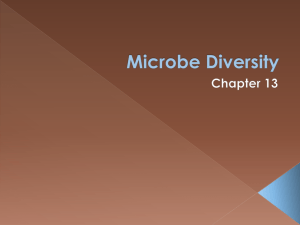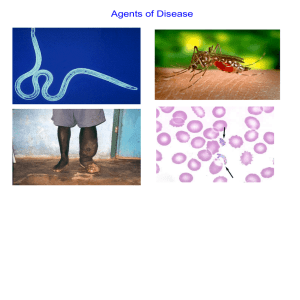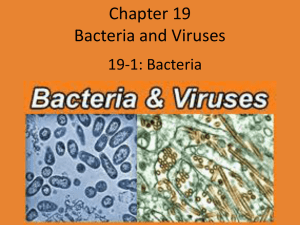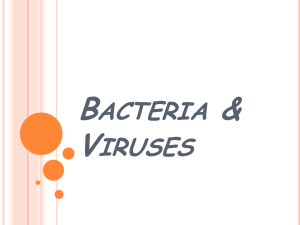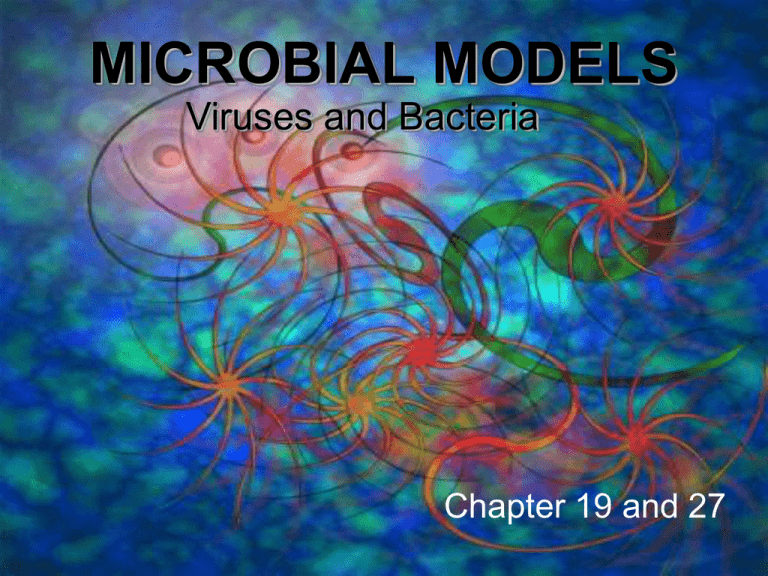
MICROBIAL MODELS
Viruses and Bacteria
Chapter 19 and 27
VIRUSES
No fossil record. When did they arise?
•
•
•
•
•
•
•
•
•
Viral Genomes
Capsids and Envelopes
Bacterial viruses (Bacteriophages)
Animal Viruses
Viral Reproduction
- Phage Reproduction
-Animal Virus Reproduction
Important Viral Diseases in Animals
Emerging Viruses
Viruses and Cancer
Viroids and Prions
Viral Genomes
Depending on the type of virus, it can have either a:
• Double-stranded DNA, or
• Single-stranded DNA, or
• Double-stranded RNA, or
• Single-stranded RNA
The nucleic acid can be either in a single linear form, or a
circular form.
Each virus has a “host range” which means it can only
infect certain types of hosts.
Capsids And Envelopes
– The capsid is a protein shell enclosing the
viral genome. Capsids are built of a large
number of protein subunits called
capsomeres, but with limited diversity.
– Some viruses have viral envelopes,
membranes cloaking their capsids.
These envelopes are derived from the
membrane of the host cell.
They also have some viral proteins and
glycoproteins.
Capsids And Envelopes, cont’d.
Haemophilus Influenza A
Herpes simplex and
Epstein Barr belong to
a group of enveloped
ds DNA viruses called
Herpesviridae
HIV
Epstein Barr Virus
The Influenza virus
belongs to a group of
enveloped ss RNA
viruses called
Orthomyxoviridae
Herpes Simplex
HIV belongs to a
group of enveloped ss
RNA viruses called
Retroviridae
Bacteriophages
A T-even phage, infecting an E.coli cell
Reproduction of Bacteriophages
•
Lytic Cycle – virulent viruses
In the lytic cycle the phage reproductive cycle culminates in the
death of the host, when the bacterium lyses and releases the phages
produced to infect others.
– Virulent phages reproduce only by a lytic cycle.
•
Lysogenic Cycle – temperate viruses
- Temperate phages, like phage lambda, use both lytic and
lysogenic cycles. During a lytic cycle, the viral genes immediately turn
the host cell into a virus-producing factory, and the cell soon lyses
and releases its viral products.
- During the lysogenic cycle, the viral DNA molecule, is
incorporated by genetic recombination into a specific site on the host
cell's chromosome.
In this prophage stage, one of its genes codes for a protein that
represses most other prophage genes.
Every time the host divides, it also copies the viral DNA and passes
the copies to daughter cells.
Occasionally, the viral genome exits the bacterial chromosome and
Lytic Cycle
Lysogenic Cycle
A temperate
phage that has
integrated its
genome into
that of its host
Animal Viruses
Depending on virus, genomes can be
dsDNA
ssDNA
dsRNA
ssRNA – retroviruses
Refer to Table 18.1 in book
Animal Viruses
Very Diverse! They differ in:
• The type of nucleic acid
they contain
• They differ in the
presence or absence of a
membranous envelope.
Viruses equipped with an
outer envelope use the
envelope to enter the host
cell.
The HIV virus is a Retrovirus
Retroviruses
have 2 identical
single-stranded
RNA molecules
for their genetic
material.
They also have an enzyme
associated with the RNA
called Reverse
Transcriptase, which
transcribes a DNA molecule
off the RNA template and
then converts it into a
double-stranded DNA. This
can then be incorporated
into the host cell’s genome.
Emerging Viruses
mutation
RNA viruses have high mutation rates because replication of their nucleic acid lacks proofreading.
Influenza strains
spread of existing viruses from one species to another
It is estimated that about three-quarters of new human diseases have originated in other animals.
For example, hantavirus, which killed dozens of people in 1993, normally infects rodents, especially deer mice.
Dissemination of a viral disease from a small, isolated population.
AIDS, present only in small populations in Africa, went unnamed and unnoticed for decades before spreading
around the world.
Affordable international travel, blood transfusion technology, sexual promiscuity, and the abuse of intravenous
drugs, allowed a previously rare disease to become a global scourge.
The Ebola Filovirus
Enveloped ss RNA virus
The AIDS / HIV VIRUS
More Emerging Viruses
The bird influenza virus is very closely related to the
human Influenza-A virus, an enveloped ss RNA virus
The SARS virus belongs to a genus of
enveloped ss RNA viruses called
Coronaviridae. This virus is also called
SARS-CoV
Viroids and Prions
Viroids, smaller and simpler than even viruses, consist of tiny molecules of naked
circular RNA that infect plants.
Their several hundred nucleotides do not encode for proteins but can be
replicated by the host's cellular enzymes.
Prions are infectious proteins that spread a disease.
They are thought to cause several degenerative brain diseases including scrapie
in sheep, "mad cow disease," and Creutzfeldt-Jacob disease in humans.
According to the leading hypothesis, a prion is a misfolded form of a normal brain
protein, which then converts normal proteins into the prion version.
Viruses living or nonliving?
– An isolated virus is biologically inert and yet it has a genetic
program written in the universal language of life.
– Because viruses depend on cells for their own propagation, they
evolved after the first cells appeared, probably fragments of
cellular nucleic acids that could move from one cell to another.
– A viral genome usually has more in common with the genome of
its host than with those of viruses infecting other hosts.
– The evolution of capsid genes may have facilitated the infection
of undamaged cells.
– Candidates for the original sources of viral genomes include
plasmids, small, circular DNA molecules that are separate from
chromosomes, and transposons, DNA segments that can move
from one location to another within a cell's genome. Both are
mobile genetic elements.
Oncoviruses
Virus
Associated cancer types
Hepatitis viruses, (hepatitis B & C)
Hepatocellular carcinoma (liver cancer).
Human papillomaviruses
Cancers of cervix, skin, anus, penis, mouth,
throat and maybe lung cancer.
Kaposi’s sarcoma-associated
herpesvirus
Kaposi’s sarcoma
Epstein–Barr virus
Burkitt’s lymphoma, Hodgkin’s lymphoma,
and Nasopharyngeal carcinoma.
Proto-Oncogenes and Oncogenes
• All cells contain genes called Proto-Oncogenes.
• These genes are actually normal genes that give rise to
proteins necessary for normal growth of the cell
• If however the expression of these proto-oncogenes is
up-regulated, their protein products will cause the cell to
grow and divide uncontrollably – leading to tumors.
• These over expressed proto-oncogenes are now called
oncogenes (cancer causing genes)
How do Viruses cause Cancer?
• Many viruses incorporate their DNA into the host’s genome
along with their own powerful promoters
• This causes host RNA polymerase to transcribe the viral DNA
at a rapid rate – allowing the virus to make millions of copies of
itself.
• Sometimes, the viral DNA may get incorporated next to a protooncogene
• This will cause the proto-oncogene to be over-expressed along
with viral genes – leading to tumors
• Some retroviruses even carry oncogenes (picked up from
previous hosts) in their genome and these get incorporated into
the host genome along with other viral genes
The Genetics of Bacteria
•
•
•
•
•
Prokaryotes
Reproduction is called Binary Fission
Single circular DNA
Plasmids and Episomes
Genetic Recombination
- Transformation
- Transduction
- Conjugation
• Transposons
• Simple and Composite insertion sequences
• Operons
- lac operon
- trp operon
The New System
• Adds a level above Kingdom called Domain
• There are three domains – two of which contain
prokaryotes and one contains eukaryotes
PROKARYOTES
No nucleus or
membrane-bound
organelles.
Domain Eubacteria(Bacteria)
Domian Archaebacteria
Prokaryotic Flagella
Prokaryotic flagella are composed of chains of the protein flagellin, are attached to
another protein that forms a hook that is inserted into the basal apparatus. The flagellum
spins around this basal apparatus in a circular motion, which is quite different from the
motion of the eukaryotic flagella. Remember what eukaryotic flagella are made of?
Prokaryotes are grouped into 4 categories based on
how they obtain their energy and carbon
• Photoautotrophs – harness light to synthesize
organic compounds from carbon dioxide –
cyanobacteria (Also plants and algae – eukaryotes)
• Chemoautotrophs – use CO2 to synthesize organic
compounds, but instead of harnessing light energy,
they obtain energy by oxidizing inorganic substances
such as H2S and NH3 (nitrogen metabolism)
• Photoheterotrophs – Harness light energy, but have
to derive their carbon from organic compounds
instead of from CO2
• Chemoheterotrophs – Consume organic molecules
for both energy and carbon – most common mode of
nutrition in prokaryotes and eukaryotes such as
protists, fungi, animals and even certain plants!
Chemoheterotrophs
• Saprobes – decomposers (get nutrition
from dead organic matter)
• Parasites – absorb nutrients from living
hosts
Chemoautotrophs
• Nitogen fixing bacteria – N2 to ammonia and ammonium
• Nitrifying bacteria – NH3 to NO2(nitrite) and NO3(nitrate)
• Denitrifying bacteria – NO3(nitrate) to N2 gas
Metabolism and Oxygen
• Obligate aerobes – absolutely must have O2
• Facultative anaerobes – aerobic if O2 is
present, fermentation if it is not
• Obligate anaerobes –hate O2 and die if
exposed to it (“Airing-out kills germs”)
• Aerobic respiration uses O2 as the final electron
acceptor
• Anaerobic respiration uses a different inorganic
molecule like sulfur or iron
DOMAIN EUBACTERIA
Eubacteria – Modern Bacteria
1. Proteobacteria – the most diverse group of bacteria
•Chemoautotrophic proteobacteria -Nitrogen-fixing bacteria – live in soil,
helpful to plants (Rhizobium)
•Photoautotrophs and photoheterotrophs (Purple bacteria) – with
chlorophyll in their plasma membranes – use H2S instead of H2O for their
version of photosynthesis (Photolysis) and release sulfur instead of oxygen
•Chemoheterotrophic proteobacteria – enteric bacteria such as E.coli,
Vibrio cholerae, Salmonella. Mostly rod-shaped (also classified as Gram
negative, facultative anaerobes)
Rhizobium bacteria
Chromatium, a proteobacterium, and the green sulfur
bacterium, Chlorobium. These photoautotrophs do not
evolve oxygen during photosynthesis, but rather produce
sulfur as a biproduct of photosynthesis.
Eubacteria – Modern Bacteria, cont’d
2.
3.
4.
5.
6.
7.
Cyanobacteria – photosynthesizers, contain chlorophyll
Gram positive bacteria – Clostridium, Bacillus (both sporeproducing), Mycoplasma pneumoniae, streptococcus
Gram negative bacteria – common disease causing bacteria like,
E.coli, Salmonella, staphylococcus, etc.
Spirochetes – Usually pathogenic. Treponema pallidum causes
syphilis, Borrelia burgdorferi causes Lyme disease.
Chlamydias – animal parasites. Chlamydia trachomatis source of
STD and common cause of blindness in the world.
Mycoplasma – the smallest free-living cells, cause walking
pneumonia in humans
Cyanobacteria
Streptococcus pneumoniae
Spirochetes
Eubacteria (Gram + or -)
Gram-staining
• Gram-negative bacteria are those that do not retain
crystal violet dye in the Gram staining protocol. Grampositive bacteria will retain the dark blue dye after an
alcohol wash, whereas Gram-negative bacteria do not.
In a Gram stain test, a counterstain (usually safranin) is
added after the crystal violet, which colors all Gramnegative bacteria a red or pink color. The test itself is
useful in classifying two distinctly different types of
bacteria based on structural differences in their cell
walls.
• Many species of Gram-negative bacteria are pathogenic,
This pathogenic capability is usually associated with
certain components of Gram-negative cell walls, in
particular the lipopolysaccharide (also known as LPS or
endotoxin) layer.
Gram Staining, cont’d.
Gram stained cerebrospinal fluid showing gram-positive
anthrax baccilli (purple rods) – these are gram + (blue)
Gram- Enteric E.coli bacilli stained with
Safranin counter stain (pink)
Most Common Eubacteria Shapes
• Spherical (cocci)
• Rod-shaped (bacilli)
• Spiral
Cocci Arrangements
SEM of Streptococcus pyogenes , causes
pharyngitis, food poisoning, scarlet fever, rheumatic
fever, skin and wound infections. Group A, Gram +
SEM of Neisseria gonorrhoeae, a Diplococcus
Gram +
SEM of Staphylococcus aureus - causes food poisoning,
toxic shock syndrome and skin and wound infections such
as scalded skin syndrome, scarlet fever. Gram +
Tetrad arrangement
Sarcina form cubes of eight (2
tetrads)
Bacilli Arrangement
Bacilli are rod-shaped bacteria. Bacilli all divide in
one plane producing a bacillus, streptobacillus,
or coccobacillus arrangement. Bacilli are
aerobes and produce spores that allow them to
lie dormant for long periods of time (anthrax)
Spirals
SEM of Vibrio cholerae, facultatively anaerobic,
curved (comma-shaped), rod prokaryote; causes
Asiatic cholera. Gram -
Spirillum
- rat-bite fever
SEM of the spirochete Leptospira interrogans
causes many diseases including meningitis Gram -
spirochete Borrelia burgdorferi (arrows)
in a blood smear causes Lyme disease.
Gram -
Cyanobacteria - Photosynthesizing
Replication of
Bacterial
Chromosome
The major component of the
bacterial genome is one
double-stranded, circular DNA
molecule.
Tight coiling of the DNA
results in a dense region of
DNA, called the nucleoid, not
bound by a membrane.
Many bacteria have plasmids,
much smaller circles of DNA.
Bacterial cells divide by
binary fission.
Plasmids
•
Plasmids, including the F plasmid and R plasmids are small, circular, self-replicating DNA
molecules.
The F Plasmid is responsible for giving a bacterium its “maleness” and allows it to develop a sex
pilus.
Episomes, are a genetic element that can exist as a plasmid or as part of a chromosome.
Episomes, like the F plasmid, can undergo reversible incorporation into the cell's chromosome.
Temperate virus genomes also qualify as episomes.
Plasmid genes are advantageous in stressful conditions.
Recombination exchanges segments of DNA.
This recombinant bacteria has genes from two different cells.
Antibiotic resistance.
–
The genes conferring resistance are carried by plasmids, specifically the R plasmid (R for resistance).
–
Some of these genes code for enzymes that specifically destroy certain antibiotics, like tetracycline or
ampicillin.
–
When a bacterial population is exposed to an antibiotic, individuals with the R plasmid will survive and
increase in the overall population.
–
Because R plasmids also have genes that encode for sex pili, they can be transferred from one cell to
another by conjugation.
Transformation
• Transformation is the alteration of a bacterial
cell's genotype by the uptake of naked, foreign
DNA from the surrounding environment.
For example, harmless Streptococcus
pneumoniae bacteria can be transformed to
pneumonia-causing cells, when a live
nonpathogenic cell takes up a piece of DNA that
happens to include the allele for pathogenicity
from dead, broken-open pathogenic cells.
Transduction
• A phage infects a susceptible bacterium and injects its DNA into the
host.
• The phage DNA proceeds to TAKE OVER the host's entire
metabolism, turning it into a PHAGE-FACTORY.
• It then directs the synthesis of PHAGE PARTS or COMPONENTS,
including phage DNA.
• As a final step in the phage life-cycle, the VARIOUS COMPONENT
PARTS in the cytoplasm are ASSEMBLED into COMPLETE
PHAGE and the cell is broken open or LYSED, releasing the newly
made phage particles.
• During the assembly process, occasional RARE MISTAKES are
made and bits of the host's bacterial DNA become incorporated
INTO THE NEW PHAGE.
• Since there is NO ROOM FOR PHAGE DNA in these situations
DEFECTIVE PHAGE are made.
• However, these defective phage still have the ability to subsequently
bind and INSERT their DNA into a host bacterial cell. But, since
these defective phage contain only bacterial DNA, an infection
DOES NOT OCCUR.
• Recombination can take place between the previous host's DNA
and the new host's DNA and any alleles carried into the host by the
defective phage can become INCORPORATED into the host's DNA,
thereby CHANGING ITS GENOTYPE
Transduction, cont’d.
General and Specialized
Conjugation
Conjugation transfers genetic
material between two bacterial cells
that are temporarily joined.
One cell ("male") donates DNA and
its "mate" ("female") receives the
genes.
A sex pilus from the male initially
joins the two cells and creates a
cytoplasmic bridge between cells.
"Maleness," the ability to form a sex
pilus and donate DNA it is a result of
an F factor as a section of the
bacterial chromosome or as a
plasmid.
Conjugation, cont’d.
DOMAIN ARCHAEBACTERIA
Archaebacteria – Ancient Bacteria
Extreme Halophiles
•Live in extremely salty environments
•Most are photosynthetic autotrophs
•The photosynthesizers in this category are purple because instead of using chlorophyll to
photosynthesize, they use a similar pigment called bacteriorhodopsin that uses all light
except for purple light, making the cells appear purple.
Methanogens
•Strict anaerobes(Hate O2!) that release methane
•Many live in mud at the bottom of lakes and swamps because it lacks oxygen, and some
live in the intestinal tracts of animals. A large number of methanogens colonize the
intestinal tracts of ruminary grazing animals, where they aid in the digestion of cellulose.
The methanogens living in the human digestive tract can cause intestinal gas.
Thermoacidophiles / Extreme Thermophiles
•Live in extremely hot or acidic water; some species can survive temperatures over 100
degrees Celsius. The famous hot springs in Yellowstone are home to this type of Archaea.
•They also live around deep-sea vents. Most hyperthermophiles are chemoautotrophs,
meaning that they use chemicals found in the water leaving the vents to directly produce
ATP.
•Often make the pools a greenish color due to their metabolic waste.
•They may also feed on dead organisms that have sunk from higher levels of the ocean.
Archaebacteria (cont’d)
Extreme Halophiles
Love salty environments
Thermoacidophiles
Or Extreme thermophiles
Love heat and / or acidity
Methanogens
Hate O2, make CH4
Archaebacteria cont’d. Thermoacidophiles
These bacteria live in very hot, acid habitats of 60-80 Co and pH
2-4, like the photo of a "Hot springs" below, the red stain on the
rocks are the prokaryotic cells.
The Role of Prokaryotes
• Many are decomposers (Saprobes)
• Some are responsible for cycling materials between biotic and
abiotic worlds because prokaryotes are the only organisms able
to metabolize inorganic molecules (N2 fixing bacteria, CO2
fixing autotrophs)
• Most are symbiotic
-Mutualism – both benefit (E.coli, Rhizobium)
- Commensalism – one benefits, the other is unaffected
- Parasitism – one benefits, the other is harmed (H.pylori)
• Some are pathogenic (cause diseases)
- Opportunistic – normal residents in/on another organism
cause disease when the organism’s “guard is down”
(due to illness)
Koch’s Postulates – 4 criteria that determine whether a
certain pathogen is the cause of a disease.
Role of Prokaryotes, cont’d.
Some bacteria produce useful antibiotics, while others
produce dangerous toxins.
• Antibiotic-producing bacteria such as actinomycetes
(streptomyces)
• Exotoxins – Protein toxins secreted by certain bacteria that can
make one ill, even if the bacteria are no longer present –
Botulism caused by Clostridium botulinum, Vibrio cholerae
• Endotoxins – lipopolysaccharide complexes associated with
the outer membrane of Gram-negative bacteria such as E. coli,
Salmonella, Shigella, Pseudomonas, Neisseria, Haemophilus,
and other leading pathogens. and can make one ill only if the
bacterium is present – Salmonella typhi poisoning
Koch's postulates
In 1890 the German physician and bacteriologist Robert Koch
set out his celebrated criteria for judging whether a given
bacterium is the cause of a given disease. Koch's criteria
brought some much-needed scientific clarity to what was
then a very confused field.
Koch's postulates are as follows:
– The bacteria must be present in every case of the disease.
– The bacteria must be isolated from the host with the disease
and grown in pure culture.
– The specific disease must be reproduced when a pure
culture of the bacteria is inoculated into a healthy
susceptible host.
– The bacteria must be recoverable from the experimentally
infected host.
Use of bacteria in industry
Oil spill clean - up
Sewage treatment
A membrane protein in the plant pathogen
Pseudomonas syringae, actually causes
water to start freezing at higher
temperatures. Potential commercial
applications? - Using the protein to
prevent frost damage to crops and making
snow for ski slopes.
Transposons – Jumping genes
How Transposons work
Transposons may help evolution of genes
Composition of the Human Genome
Long terminal repeat
Short interspersed
nuclear elements
HERVs
long interspersed
nuclear elements
THE END



